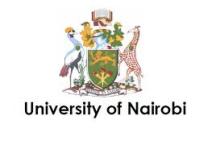Resource information
Due to the increased concerns about the effect of agrochemicals
on soil health and soil biodiversity, use of
biological methods has become most acceptable
alternative methods for farmers to control soil
pathogens during crop production. A study was
therefore undertaken to determine the occurrence of
nematode destroying fungi in Taita Taveta with the
aim of isolating and characterizing them for biological
control of plant parasitic nematodes. Twenty eight
fungal isolates, distributed in three genera, were
identified as nematode destroying fungi from all the
positive soil samples. Out of the isolates that were
identified, 71, 25 and 4 % were in the genera
Arthrobotrys, Monacrosporium and Nematoctonus
respectively. Arthrobotrys oligospora had an
occurrence frequency of 42.9% which was the highest
followed by A. dactyloides, M.cionopagum,
Monacrosporium sp and Nematoctonus sp with
frequencies of 28.6, 17.9 and 7.1and 3.6%
respectively. The occurrence of nematode destroying
fungi was affected by land use and organic inputs (P ≤
0.05) while it was not affected by crop rotation (P ≥
0.05). Napier land use was more diverse than the other
land uses with a mean shannon diversity index of
0.717 followed by horticulture (index 0.497). Maize
/bean, coffee/beans, fallow and shrub land uses had a
mean shannon index of 0. The same trend was
observed on richness where napier had a mean
richness of 2.2, horticulture 1.8, maize bean 1 while
shrub, fallow and coffee/ beans all had mean richness
of 0.2. A.oligospora was the most frequently isolated
fungi (42.9 %) and showed high potential in biocontrol
of plant-parasitic nematodes and was recommended
for further studies and development as a biological
control agent


